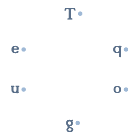• • •
In terms of friction, religious tolerance and intolerance, in terms of good, evil, survival and safety, there has been one long historic period when one religion dominated but treated two rival religions as equals. For nearly eight hundred years the Muslim religion ruled Spain and in the high culture of its capital, Cordoba, Christians and Jews were treated by the Moslems as equals. For Western Europe this was the period called The Dark Ages. But in Spain all lights were on.
From 750 to 1492 a half a million people lived in Cordoba, the center of the Western Ummayid Caliphate. Cordoba had 113,000 homes and 21 suburbs, 70 libraries, numerous bookshops and palaces, 700 mosques and 300 public baths. To give this last figure perspective: "When the University of Oxford [founded in 1264] still looked upon bathing as a heathen custom, generations of Cordovan scientists had been enjoying baths in luxurious establishments." (Hitti)
Lights from the bordering houses illuminated miles of paved streets. And again to give perspective, "700 years after this time, there was not so much as one public lamp in London and in Paris; centuries subsequently, whoever stepped over his threshold on a rainy day stepped up to his ankles in mud." (Draper)
"Whenever the rulers of Leon, Navarre, or Barcelona needed a surgeon, an architect, a master singer, or a dressmaker, it was to Cordoba that they applied " (Hitti) There were 13,000 weavers of silk and wool; from Spain Morocco learned the art of tanning and embossing leather. In Spain, the Muslims invented paper, printing, glass and the water wheel; their gardeners learned how to use fertilizer and how to graft. From Valencia they exported citrus and rice, and from three Spanish provinces they exported 20,000 pounds of gold every year beginning in 750.
Except for the harp and the zither which were used in the Orient still earlier, all the musical instruments of the Middle Ages were of Muslim origin, including the lute [Arab 'ud], the bow for the violin and the viol. The rhyming of poetry, as well as the complexities of poetic meters, also came from Muslim Spain.
Cordoba was a city of education. Caliph Hakam II, opened 27 free schools for the poor and for both women and men. The University of Cordoba, the sole great center of learning in Europe, had 4000 students as early as 775. By 1000 the Caliph's personal library contained 400,000 volumes. (Ibn Khaldun)
Such a remarkable spread of literacy among an entire population, and for men and women alike stimulated, among other things, widespread interest in Arabic poetry. This interest gave birth to the popular songs of Jazal and Muwashshah, the precursors of the songs of love and chivalry of medieval Europe.
Of Arabic poetry in general, Hitti says, "Wherever and whenever the Arabic language was used there the passion for poetical composition was intense. Verses countless in number passed from mouth to mouth and were admired by high and low, not so much perhaps for their contents as for their music and exquisite dictions. This sheer joy in the beauty and euphony of words, a characteristic of Arabic-speaking people, first manifested itself on Spanish soil. The first Ummayyad sovereign was a poet and so were several of his successors."
The year 1000 AD: the year the spiritual center of Judaism moved from Mesopotamia to Spain, the year that Arabs and Jews became court physicians in Germany, the year that the Indian mathematician, Sridhara, recognized the importance of the zero, the year the Chinese perfected the invention of gunpowder although, until 1151, it was only used for firecrackers and turning prayer wheels.
Summary as extracted from twenty-eight books including:
• "History of the Arabs" by Philip K. Hitti (St. Martin's Press, Macmillan, 1967, ninth edition)
• "The Muquddimah: An Introduction To History" by Ibn Khaldun and translated from the Arabic by Franz Rosenthal (Bollingen Series XLIII, Pantheon Books 1958)
• "A History of the Jews in Christian Spain" by Yitzak Baer (Volume I "From the Age of Reconquest to the Fourteenth Century" [The Jewish Publication Society of America, Philadelphia 1961])
• "History of the Moslems of Spain" by Dozy
• "A history of the Intellectual Development of Europe" by John Draper
All this has happened. Such tolerance, such enlightenment can happen again.
Context: response to universal and existential need and danger. Both need and danger are due to climate change, nuclear threat, religious friction, failure to shout out to the challenge, "Here we come!"
Equobenity: our prophetic choice of attitude:
T.
with determination in e.
and respect for q.
for a continual alternation between the two
we will come to the new place


